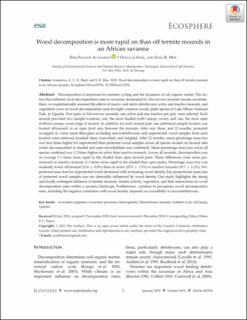| dc.description.abstract | Decomposition is important for nutrient cycling and the dynamics of soil organic matter. The factors that influence local decomposition rates in savannas dominated by Macrotermes mounds remain uncertain. Here, we experimentally assessed the effects of macro- and micro-detritivores, active and inactive mounds, and vegetation cover on wood decomposition rates for eight common woody plant species in Lake Mburo National Park, in Uganda. Five pairs of Macrotermes mounds, one active and one inactive per pair, were selected. Each mound provided two sample locations, one, the most shaded (with canopy cover), and one, the most open (without canopy cover) edge of mound. In addition, for each mound pair, one additional sample location was
located off-mound, in an open level area between the mounds. After one, three, and 12 months, protected (wrapped in 1-mm mesh fiber-glass excluding macrodetritivores) and unprotected wood samples from each location were retrieved, brushed clean, oven-dried, and weighed. After 12 months, mean percentage mass loss was four times higher for unprotected than protected wood samples across all species located on mound sites
(when decomposition in shaded and open microhabitats was combined). Mean percentage mass loss across all species combined was 1.2 times higher on active than inactive mounds. Across all mounds, decomposition was on average 1.1 times more rapid in the shaded than open mound parts. These differences were more pronounced on inactive mounds (1.3 times more rapid in the shaded than open parts). Percentage mass loss was markedly lower off-mound (12.6 0.8%) than on active (25.9 1.5%) or inactive mounds (19.7 1.2%). Proportional mass loss for unprotected wood decreased with increasing wood density, but proportional mass loss of protected wood samples was not detectably influenced by wood density. Our study highlights the strong and locally contingent influence of termite mounds, termite activity, vegetation, and their interactions on wood decomposition rates within a savanna landscape. Furthermore, variation in per-species wood decomposition rates, including the negative correlation with wood density, depends on accessibility to macrodetritivores. | en_US |

